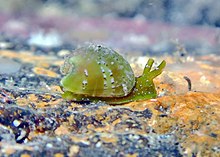The radula is an anatomical structure used by mollusks for feeding, sometimes compared to a tongue. It is a minutely toothed, chitinous ribbon, which is typically used for scraping or cutting food before the food enters the esophagus. The radula is unique to the mollusks, and is found in every class of mollusk except the bivalves, which instead use cilia, waving filaments that bring minute organisms to the mouth.

Sacoglossa are a superorder of small sea slugs and sea snails, marine gastropod mollusks that belong to the clade Heterobranchia known as sacoglossans. There are 284 valid species recognized within this superorder. Sacoglossans live by ingesting the cellular contents of algae, hence they are sometimes called "sap-sucking sea slugs". Some sacoglossans simply digest the fluid which they suck from the algae, but in some other species, the slugs sequester and use within their own tissues living chloroplasts from the algae they eat, a very unusual phenomenon known as kleptoplasty, for the "stolen" plastids. This earns them the title of the "solar-powered sea slugs", and makes them unique among metazoan organisms, for otherwise kleptoplasty is known only among other euthyneurans and single-celled protists.
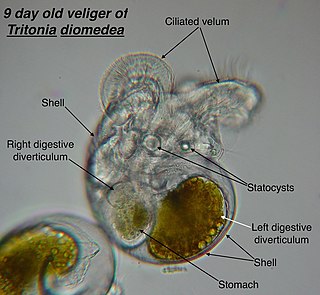
A veliger is the planktonic larva of many kinds of sea snails and freshwater snails, as well as most bivalve molluscs (clams) and tusk shells.

Elysia chlorotica is a small-to-medium-sized species of green sea slug, a marine opisthobranch gastropod mollusc. This sea slug superficially resembles a nudibranch, yet it does not belong to that clade. Instead it is a member of the clade Sacoglossa, the sap-sucking sea slugs. Some members of this group use chloroplasts from the algae they eat for photosynthesis, a phenomenon known as kleptoplasty. Elysia chlorotica is one species of such "solar-powered sea slugs". It lives in a subcellular endosymbiotic relationship with chloroplasts of the marine heterokont alga Vaucheria litorea.

The Trochidae, common name top-snails or top-shells, are a family of various sized sea snails, marine gastropod molluscs in the subclass Vetigastropoda. This family is commonly known as the top-snails because in many species the shell resembles a toy spinning top.
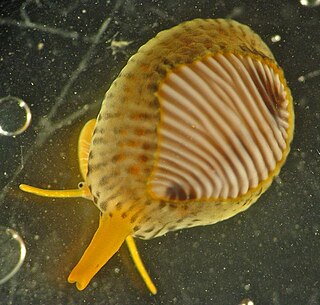
Trivia monacha, also known as the European cowrie or spotted cowrie, is a species of small sea snail, a marine gastropod mollusc in the family Triviidae, the trivias.
A valve is each articulating part of the shell of a mollusc or another multi-shelled animal such as brachiopods and some crustaceans. Each part is known as a valve or in the case of chitons, a "plate". Members of two classes of molluscs, the Bivalvia (clams) and the Polyplacophora (chitons), have valves.

Elysia pusilla is a species of small sea slug, a marine gastropod mollusk in the family Plakobranchidae. It is a sacoglossan.

Juliidae, common name the bivalved gastropods, is a family of minute sea snails, marine gastropod mollusks or micromollusks in the superfamily Oxynooidea, an opisthobranch group.

Plakobranchus ocellatus is a species of sea slug, a sacoglossan, a marine opisthobranch gastropod mollusk in the family Plakobranchidae. It is found in shallow water in the Indo-Pacific region.

Costasiella kuroshimae—also known as a "leaf slug", or "leaf sheep"—is a species of sacoglossan sea slug. Costasiella kuroshimae are shell-less marine opisthobranch gastropod mollusks in the family Costasiellidae. Despite being animals they indirectly perform photosynthesis, via kleptoplasty.

Julia is a genus of minute sea snails, marine gastropod mollusks or micromollusks in the superfamily Oxynooidea.
Julia mishimaensis is a species of a sea snail with a shell comprising two separate hinged pieces or valves. It is a marine gastropod mollusk in the family Juliidae.
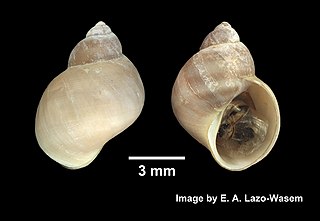
Lacuna vincta, commonly known as northern lacuna, wide lacuna, northern chink shell, or banded chink shell, is a species of sea snail, a marine gastropod mollusk in the family Littorinidae, the winkles or periwinkles. It is found intertidally and in shallow waters in both the northern Atlantic Ocean and the northern Pacific Ocean. It is a herbivore, feeding on seaweed and diatoms with its toothed radula.
Aiteng ater is a species of sea slug, a marine gastropod mollusc in the family Aitengidae. The specific name ater is from the Latin language and means black, in reference to the appearance of the slug on the mud.
Aplysia morio, the Atlantic black sea hare or sooty sea hare, is a species of sea slug, a marine gastropod mollusk in the family Aplysiidae, the sea hares. It lives in warm waters in the Caribbean Sea and off the south and southeastern coast of the United States, where it feeds on seaweed.
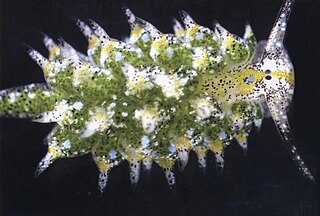
Costasiella ocellifera is a small (5–13 mm) species of sea slug, a shell-less marine gastropod mollusk in the family Costasiellidae. Costasiella ocellifera, and other members of the Costasiellidae family are often mistakenly classified as nudibranchs because they superficially resemble other species of that group, but they are actually a part of the Sacoglossa superorder of sea slugs, also known as the “sap-sucking sea slugs,” "crawling leaves" or the "solar-powered sea slugs." C. ocellifera was discovered by Simroth in 1895, and was initially classified as Doto ocellifera. The Brazilian species, Costasiella liliana, is a synonym of C. ocellifera.Costasiella ocellifera shows long-term retention of functional kleptoplasty.

Thuridilla vataae is a species of sacoglossan sea slug, a shell-less marine opisthobranch gastropod mollusc in the family Plakobranchidae. It is native to the tropical Indo-Pacific. It was first described by the French zoologist Jean Risbec in 1928; its specific name refers to the Bay of Anse Vata, just south of Nouméa, New Caledonia, where the type specimen was collected.

Thuridilla moebii is a species of sacoglossan sea slug, a shell-less marine opisthobranch gastropod mollusc in the family Plakobranchidae. It is found in shallow water in the tropical west and central Indo-Pacific region.
